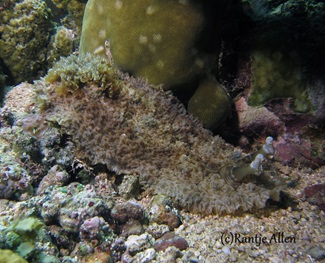Loading content - please wait...
Dendrodoris tuberculosa inhabits Gorontalo reefs
Dendrodoris tuberculosa rarely appears on Gorontalo’s coral rich dive sites, despite its very large size. After years of absence, in late 2023 divers saw three in the same week!
The Frilly Dendrodoris tuberculosa
Sometimes called the Tuberculate Dendrodoris nudibranch, it can grow to twenty centimeters in length. Colors range from brown to green to pink. Most distinctive about this giant nudibranch are its numerous tubercules. These almost entirely cover its upper body. Among the masses of tubercules, two rhinophores emerge. Perhaps because of its large size, it crawls quite fast. Despite its size, divers can easily miss seeing it.
Three in One Week
The first of three we spotted recently looked like a scrap of old carpet flowing over the substrate. It easily blended in and quickly disappeared under some coral. This sighting was at a depth of two meters. Its length was twenty centimeters.
The second Dendrodoris tuberculosa sighted was at twelve meters. It was crawling on top of plate coral that projected from one of Gorontalo’s spectacular walls. Its pinkish color contrasted nicely with the coral. Much smaller than the first, it measured about twelve centimeters in length. After crawling across the coral, it turned upside down and disappeared underneath the coral.
The third Tuberculate Dendrodoris had beautiful bluish tips on its tubercules. It was still on the small side, measuring about ten centimeters.
Discovery during Around-the-World Expedition
This enormous nudibranch was first discovered during a scientific voyage around the world. Commissioned by the French king, the voyage departed the port city of Toulon on 22 April 1826. The name of the ship was Astrolabe, after an instrument used in marine navigation. Scientists on board collected samples of animals and plants from the coasts of Chile and Peru, Australia, New Zealand, New Guinea, and various Pacific islands. They also surveyed the Molucca islands of Indonesia.
Two French naturalists Quoy and Gaimard named one discovery Doris tuberculosa. The genus name later changed to Dendrodoris.
The expedition returned to France in March 1825.
For your chance to enjoy a dive expedition in Gorontalo, please make your dive reservations directly with Miguel’s Diving.








